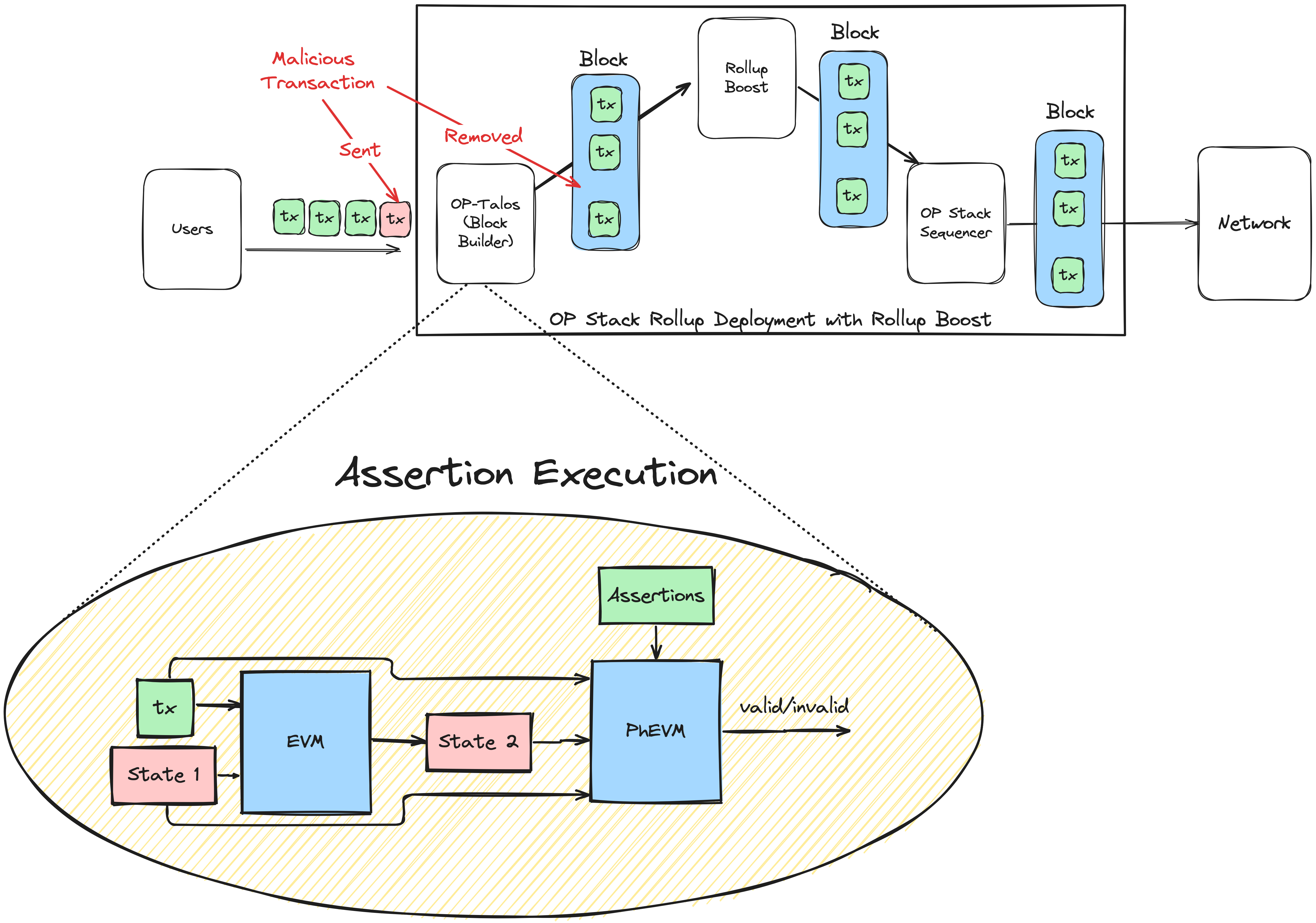Skip to main contentThe OP Stack implementation uses Rollup-Boost to connect an external sidecar assertion validation components with the L2 sequencer through a bridge proxy.
Architecture Diagram
System Components
Sequencer
- op-node: The main orchestrator node in the OP Stack, responsible for sequencing transactions and maintaining consensus with the execution layer.
- op-geth/op-reth: The execution layer clients (Geth or Reth) that process and execute transactions, providing the EVM environment for the rollup.
Credible Layer (Sidecar)
- Block Builder: The component of the network that simulates transactions and runs assertions before transaction finalization to ensure they don’t violate defined conditions.
- op-reth: The execution layer client within the Credible Layer that processes transactions and maintains state.
pcl CLI: Command-line interface for developers to write, test, and submit assertions to the system.- dApp: The web application interface to deploy, manage, and view assertions and projects.
- Assertion DA: The Assertion Data Availability layer, which stores assertion bytecode and serves it to both end-users and the Assertion Enforcer for execution.
Rollup-Boost
- Proxy: Acts as a bridge between the block builder and the sequencer, enabling integration without requiring changes to the sequencer code. It handles new block requests and fallback validation.
Component Interactions
- The Credible Layer op-reth pulls state and transactions from the Sequencer op-geth/op-reth.
- The Credible Layer op-reth provides best transactions to the Block Builder.
- The Block Builder enforces assertions and produces credible blocks, which are requested by Rollup-Boost.
- Rollup-Boost requests credible blocks from both the Block Builder and the Sequencer op-node.
- The Assertion DA serves assertion bytecode to the Block Builder, ensuring up-to-date enforcement.
pcl and the Credible dApp provide interfaces for assertion development, submission and management.
Transaction Flow
 The diagram above illustrates transaction flow through the OP Stack implementation. The top section shows the complete deployment: users submit transactions that flow through OP-Talos (block builder) → Rollup-Boost → OP Stack Sequencer → Network. Malicious transactions are identified and removed before reaching the sequencer.
The bottom section zooms into assertion execution - this process is consistent across all Credible Layer implementations, not just OP Stack. The transaction and State 1 (pre-state) flow into the EVM for simulation, producing State 2 (post-state). PhEVM then validates these states against deployed assertions, returning valid/invalid.
The diagram above illustrates transaction flow through the OP Stack implementation. The top section shows the complete deployment: users submit transactions that flow through OP-Talos (block builder) → Rollup-Boost → OP Stack Sequencer → Network. Malicious transactions are identified and removed before reaching the sequencer.
The bottom section zooms into assertion execution - this process is consistent across all Credible Layer implementations, not just OP Stack. The transaction and State 1 (pre-state) flow into the EVM for simulation, producing State 2 (post-state). PhEVM then validates these states against deployed assertions, returning valid/invalid.
Key Technologies
- OP-Talos: Implementation of rbuilder as the Assertion Enforcer. rbuilder is Flashbots’ open-source block builder, which we’ve adapted to include assertion validation logic for the OP Stack.
- Rollup-Boost: Developed by Flashbots, Rollup-Boost is a proxy architecture that enables external block builders to integrate with rollup sequencers. It integrates OP-Talos with the Sequencer without requiring code changes to the Sequencer, allowing for modular and non-invasive assertion enforcement.
Integration Benefits
This solution provides several advantages for OP Stack networks:
- Non-invasive: No modifications required to the sequencer code
- Modular: Assertion validation runs as a separate, upgradable component
- Performant: Parallel assertion execution doesn’t impact sequencer performance
- Flexible: Easy to enable/disable assertion enforcement
For more details on the general architecture and other implementations, see the Architecture Overview. 

